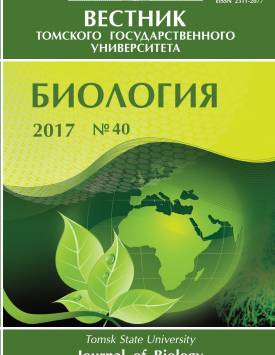Spatial organization of bird communities of Prytymye
The aim of our research was to establish the main tendencies of territorial changes of bird communities of Pritymye and environmental factors determining these tendencies. Pritymye, until recently, has remained one of the least investigated areas of Western Siberia in ornithological respect. The ecological state of most landscapes and ornithocomplexes of this area is little disturbed. Therefore, the evaluation of spatial diversity of bird communities of Pritymye can be used to identify anthropogenic changes of bird communities in other areas in the middle taiga of Western Siberia, more susceptible to industrial and economic use. We counted birds on constant routes with recalculation of the square according to average detection distances (Ravkin, Livanov, 2008) mainly in the valley of the Tym river in the North-Eastern part of Tomsk region from 16 may to 15 July 1985 and 20062007. We investigated 31 habitats (500 km of overland and 300 km of water routes) in the valley of the Tym river and the adjacent interfluve at 3 sites. The first of these was located in the lower flow of the Tym river (59°30'N, 80°20'E), the second - in the middle (59°53'N, 82°00'E) and the third - in the upper flow of this river (60°23'N, 84°14'E). We estimated spatial organization (regularity, structuring) of bird communities by dispersion of similarity coefficients between ornithocomplexes, accounted by environmental factors and their combinations selected in classification and structural constructions (Vartapetov, 1998). Methods for bird counting, calculation algorithms, and principles of classification and construction of graphs have been described in detail earlier (Ravkin, Livanov, 2008; Vartapetov, Preobrajenskaya, 2010). We established total territorial changes of bird communities connected with a decrease in forestation, a change of dark-coniferous forest species to small-leaved ones and the impact of floodland regime. At the same time, the productivity of biocenoses and the total abundance of birds increased. The total density of bird communities decreases during reduction of the productivity of biocenoses, depletion of the mineral nutrition of phytocoenoses, and cutting down of pine forests. More specific trends in ornithocomplexes are associated with the presence of villages (total abundance of birds increases, and their species richness reduces); with water content increasing the number of species and individuals in bird communities reduces (See Fig. and Table). When comparing with bird communities in the Ket and Vasyugan river basins, adjacent to the territory under consideration from the south, we noted, that in forest landscapes the species richness and the total abundance of birds is greater in the most wooded and less disrupted territories; in meadow ornithocomplexes these parameters increase southwards, whereas in raised swamps - northwards. The article contains 1 Figure, 1 Table and 19 Referenses.
Keywords
density of communities, species richness, West Siberia, middle taiga, environmental factors, видовое богатство, плотность населения, средняя тайга, Западная Сибирь, факторы средыAuthors
| Name | Organization | |
| Vartapetov Lev G. | Institute of Systematics and Ecology of Animals, Siberian Branch of the Russian Academy of Sciences | lev@eco.nsc.ru |
| Zheleznova Tatiana K. | Russian State Agrarian University - Moscow Timiryazev Agricultural Academy | larus-minutus@yandex.ru |
References

Spatial organization of bird communities of Prytymye | Vestnik Tomskogo gosudarstvennogo universiteta. Biologiya - Tomsk State University Journal of Biology. 2017. № 40. DOI: 10.17223/19988591/40/7
